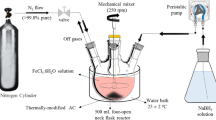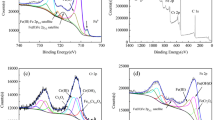Abstract
Zerovalent iron (ZVI) has drawn intense interest as an effective and inexpensive tool to enhance degradation of various environmental contaminants. Reduction of Cr(VI) to Cr(III) by ZVI merits environmental concern as a hazardous species is transformed into a non-hazardous one. Objectives of this research were to assess kinetics and capacity of Cr(VI) reduction by different sources of ZVIs, of which chemical parameters can base in situ application of ZVI to treat Cr(VI) contaminated water. Reduction kinetics were first-order and rapid showing that 50% of the initial Cr(VI) was reduced within 7.0 to 347 min depending on Cr(VI) concentration, temperature and ZVI source. The reduction rates were increased with decreasing the initial Cr(VI) concentrations and increasing the reaction temperatures. The J ZVI (Shinyo Pure Chemical Co., Japan) was more effective in Cr(VI) reduction than PU (Peerless Metal Powders, USA). The maximum reduction capacities of J and PU ZVIs at 25°C were 0.045 and 0.042 mmol g−1 Fe0, respectively. A relatively higher value of the net reaction energy (E a ) indicated that Cr(VI) reduction by ZVI was temperature dependent and controlled by surface properties of ZVI. Chemical parameters involved in the Cr(VI) reduction by ZVI such as temperature quotient, kinetic rates, and stoichiometry indicated that the ZVI might be effective for in situ treatment of the Cr(VI) containing wastewater.
Similar content being viewed by others
References
Babel, S. and Kurniawan, T. A., “Low-cost adsorbent for heavy metals uptake from contaminated water: A review,” J. Hazad. Mater., B97, 219 (2003)
Bartlett, R. J. and James, B. R., “Chromium,” In Sparks, D. L. (ed.), Method of soil analysis, Part 3, Soil Sci. Soc. Am., Madison, WI, USA, 683 (1996).
Blowes, D.W., Ptacek, C. J. and Jambor, J. L., “In-situ remediation of Cr(VI) contaminated groundwater using permeable reactive walls,” Environ. Sci. Technol., 31, 3348 (1997).
Choi, D.W. and Kim, Y. H., “Chromium(VI) removal in a semi-continuous process of hollow fiber membrane with organic extractants,” Korean J. Chem. Eng., 22, 894 (2005).
Comfort, S. D., Shea, P. J., Machacek, T.A. and Satapanajaru, T., “Pilotscale treatment of RDX-contaminated soil with zerovalent iron,” J. Environ. Qual., 32, 1717 (2003).
Dantas, T.N. D., Neto, A. A. D. and Moura, M. C. P., “Removal of chromium from aqueous solutions by diatomite treated with microemulsion,” Wat. Res., 35, 2219 (2001).
EPA, Permeable reactive barrier technologies for contaminant remediation, EPA OSWER, USA, EPA/600/R-98/125 (1998).
Fendorf, S. E. and Li, G., “Kinetics of chromate reduction by ferrous iron,” Environ. Sci. Technol., 30, 1614 (1996).
Hamadi, N. K., Chen, X. D., Farid, M. M. and Lu, M.G. Q., “Adsorption kinetics for the removal of Chromium(VI) from aqueous solution by adsorbents derived from used tyres and sawdust,” Chem. Eng. J., 84, 95 (2001).
Hernandez, R., Zappi, M. and Kuo, C. H., “Chloride effect on TNT degradation by zerovalent iron or zinc during water treatmen,” Environ. Sci. Technol., 38, 5157 (2004).
Holan, Z. R., Volesky, B. and Prasetyo, I., “Biosorption of cadmium by biomass of marine algae,” Biotechnol. Bioeng., 41, 819 (1993).
Khan, S. A. Rehman, R. and Khan, M. A., “Adsorption of Chromium (III), Chromium(VI) and Silver(I) on bentonite,” Waste Manage., 15, 271 (1995).
Lasaga, A.C. and Kirkpatrick, R. J., Kinetics of geochemical processes, Mineral. Soc. Am., Washington, DC, USA (1983).
Lee, D. C., Park, C. J., Yang, J. E., Jeong, Y.H. and Rhee, H. I., “Screening of hexavalent chromium biosorbent from marine algae,” Appl. Microbio. Biotechnol., 54, 445 (2000).
Lee, D. H., Min, Y.W., Rhee, H. I., Yang, J. E., Chun, G. T. and Jeong, Y. H., “Removal of chromate by white rot fungus, Inonotus cuticularis,” J. Microbial. Biotechnol., 12, 292 (2002).
Lee, T., Lim, H., Lee, Y. and Park, J.W., “Use of waste iron metal for removal of Cr(VI) from water,” Chemosphere, 53, 479 (2003).
Losi, M. E., Amrhein, C. and Frankenberger, W. T., “Bioremediation of chromate-contaminated groundwater by reduction and precipitation in surface soils,” J. Environ. Qual., 10, 1141 (1994).
Namasivayam, C. and Ranganathan, K., “Waste Fe(III)/Cr(III) hydroxide as adsorbent for the removal of Cr(VI) from aqueous solution and chromium plating industry wastewater,” Environ. Poll., 82, 255 (1993).
Ok, Y. S., Lim, S. and Kim, J.G., “The application of dual function organoclay on remediation of toxic metals and organic compounds in soilwater system,” Korean J. Environ. Agric., 22, 177 (2003).
Ouki, S. K. and Kavannagh, M., “Performance of natural zeolites for the treatment of mixed metal-contaminated effluents,” Waste Manage. Res., 15, 383 (1997).
Park, J., Comfort, S. D., Shea, P. J. and Machacek, T. A., “Remediating munitions-contaminated soil with zerovalent iron and cationic surfactants,” J. Environ. Qual., 33, 1305 (2004).
Ponders, S.M., Darab, J.G. and Mallouk, T. E., “Remediation of Cr(VI) and Pb(II) aqueous solutions using supported, nanoscale zero-valent iron,” Environ. Sci. Technol., 34, 2564 (2000).
Prakorn, R., Kwanta, N. and Ura, P., “One-through selective separation of copper, chromium and zinc ions by hollow fiber supported liquid membrane,” Korean J. Chem. Eng., 21, 1212 (2004).
Salibury, F.B. and Ross, C., Plant physiology, 4th eds. Wadsworth Publ. Co., USA (1992).
Song, D. I., Kim, Y. H. and Shin, W. S., “A simple mathematical analysis on the effect of sand in Cr(VI) reduction using zero valent iron,” Korean J. Chem. Eng., 22, 67 (2005).
Sparks, D. L., Environmental soil chemistry, Academic Press, USA (1995).
Yang, J. E., Kim, J. S., Ok, Y. S. and Yoo, K.Y., “Mechanistic evidence and efficiency of Cr(VI) reduction in water by different sources of zerovalent irons,” Water Sci. Technol., (in press) (2006).
Yang, J. E., Kim, J. S., Ok, Y. S. and Yoo, K.Y., “Reduction efficiency of Cr(VI) in an aqueous solution by different sources of zerovalent irons,” Korean J. Environ. Agric., 24, 203 (2005).
Yang, J. E., Kim, Y.K., Kim, J.H. and Park, Y. H., Environmental impacts and management strategies of trace metals in soil and groundwater in the republic of Korea, In: Soil and Groundwater Pollution and Remediation, P. M. Huang and I. K. Iskander, eds., CRC Press, New York (2000).
Yang, J. E. and Skogley, E.O., “Diffusion kinetics of multinutrient accumulation by mixed-bed ion-exchange resin,” Soil Sci. Soc. Am. J., 56, 408 (1992).
Author information
Authors and Affiliations
Corresponding author
Rights and permissions
About this article
Cite this article
Yang, J.E., Kim, J.S., Ok, Y.S. et al. Capacity of Cr(VI) reduction in an aqueous solution using different sources of zerovalent irons. Korean J. Chem. Eng. 23, 935–939 (2006). https://doi.org/10.1007/s11814-006-0011-5
Received:
Accepted:
Issue Date:
DOI: https://doi.org/10.1007/s11814-006-0011-5




